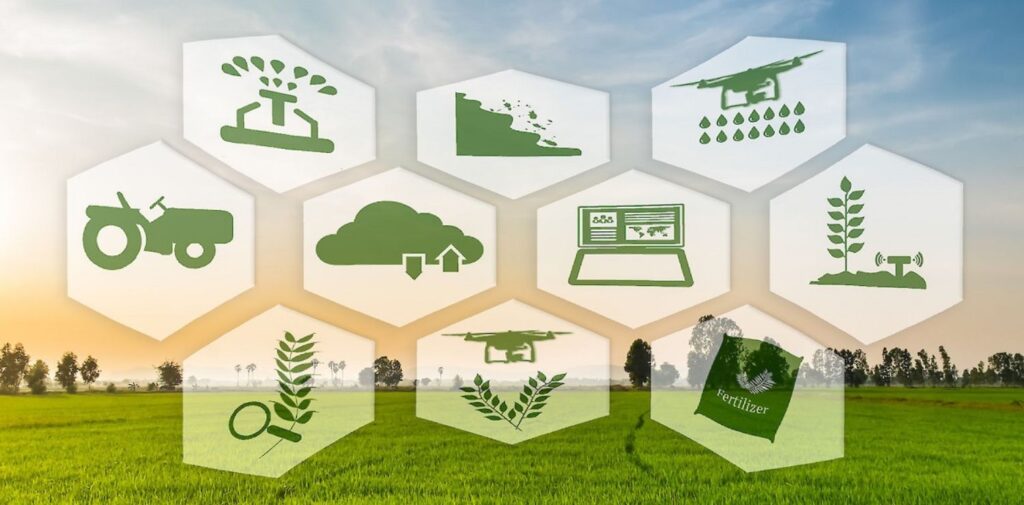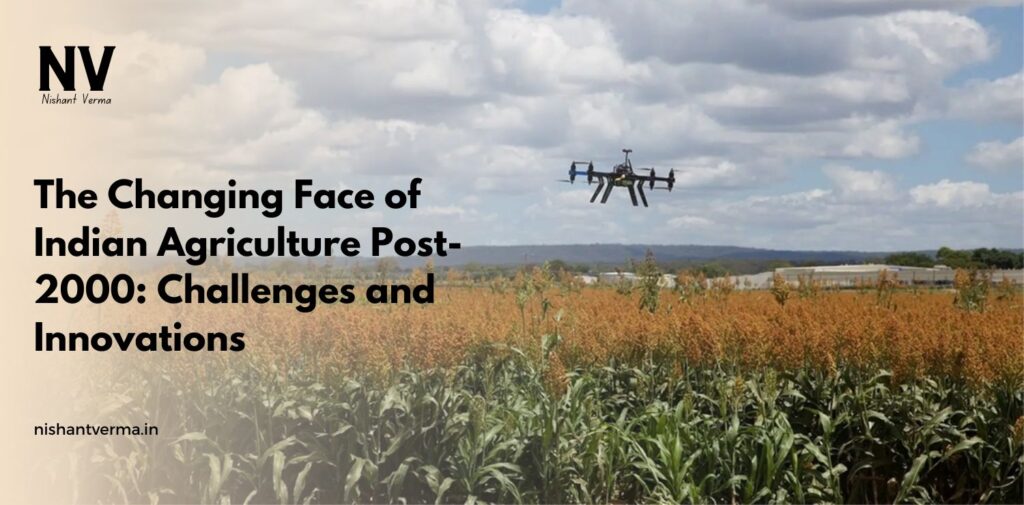Agriculture has always been the backbone of India’s economy, employing over half of the country’s workforce. However, since the turn of the century, the agricultural sector has witnessed significant changes due to various challenges, technological innovations, and policy shifts. These changes have shaped the way farming is practiced and have influenced the overall development of rural India.
In this article, we explore the major shifts in Indian agriculture post-2000, focusing on the challenges faced by farmers, the innovations introduced to tackle these issues, and the impact of new technologies and policies.
Challenges Faced by Indian Agriculture
Indian agriculture has always been susceptible to a variety of challenges. However, in the years following 2000, these challenges became more pronounced, affecting both farmers and the overall economy.
1. Climate Change and Unpredictable Weather
One of the biggest challenges Indian farmers have faced is climate change. Unpredictable rainfall, frequent droughts, and extreme temperatures have made farming increasingly difficult. Traditional crops are no longer able to withstand erratic weather patterns, leading to crop failures and reduced yields. This has significantly affected the livelihoods of farmers, especially in areas dependent on rain-fed agriculture.
2. Dependence on Monsoon
A large part of India’s agriculture still relies on the monsoon season. While efforts have been made to improve irrigation systems, a large number of farmers continue to depend on rainfall for water. In years of inadequate or delayed monsoons, agricultural output is severely impacted, leading to food shortages and higher prices.
3. Declining Soil Fertility and Water Scarcity
Over time, soil fertility has declined due to excessive use of chemical fertilizers and pesticides. This has led to lower crop productivity. Additionally, over-exploitation of groundwater for irrigation has led to severe water scarcity in many agricultural regions, making farming unsustainable in some areas.
4. Economic Pressures and Low Income
Despite being the primary source of livelihood for millions of people, farming often fails to provide a stable income. The rising cost of inputs like seeds, fertilizers, and pesticides, combined with fluctuating market prices for crops, has left many farmers in debt. This economic pressure has contributed to an increase in farmer suicides in some regions of India.

Government Policies and Support
In response to the challenges faced by the agricultural sector, the Indian government has implemented a variety of policies and schemes over the years. These initiatives aim to improve the lives of farmers and modernize agriculture.
1. Minimum Support Price (MSP) System
The government has implemented the MSP system to ensure that farmers receive a guaranteed price for certain crops, which helps protect them from price volatility in the markets. While this system has been beneficial in stabilizing farmers’ incomes for select crops, it has also been criticized for not covering enough crops and for its implementation challenges.
2. Pradhan Mantri Fasal Bima Yojana (PMFBY)
Launched in 2016, PMFBY is a crop insurance scheme designed to protect farmers against crop losses due to natural calamities, pest attacks, and other unforeseen factors. The aim of this scheme is to reduce the financial burden on farmers during tough times. Despite its potential, there have been issues with effective implementation in some regions.
3. Doubling Farmers’ Income
The government has set a target to double farmers’ income by 2022. To achieve this, the focus has been on increasing agricultural productivity, improving infrastructure, providing better access to markets, and reducing the dependency on traditional farming methods.

Innovations Transforming Indian Agriculture
While Indian agriculture faces several challenges, there have also been significant innovations that are transforming farming practices and improving productivity. These innovations are helping farmers adapt to changing conditions and increasing their incomes.
1. Technological Advancements in Farming
The adoption of technology has been one of the most important shifts in Indian agriculture. From smart farming to the use of drones, technology is revolutionizing the way agriculture is practiced.
- Precision Farming: Farmers are now using GPS technology and sensors to monitor soil moisture, temperature, and crop health. This data helps farmers make informed decisions about irrigation, fertilization, and pest control, leading to higher yields and lower costs.
- Mobile Apps for Agriculture: There has been a rise in the use of mobile applications that provide farmers with information about weather forecasts, crop diseases, market prices, and best practices. Apps like “Kisan Suvidha” and “AgriApp” are helping farmers make better decisions, reducing their dependence on middlemen and improving their profits.
2. Genetically Modified (GM) Crops
In recent years, genetically modified (GM) crops have gained attention in India. While there is ongoing debate over the safety and long-term effects of GM crops, they hold the potential to boost yields and increase resistance to pests and diseases. Bt cotton, a genetically modified cotton variety, has already been successfully adopted by Indian farmers, significantly increasing cotton production.
3. Organic Farming and Sustainable Practices
In response to the negative environmental impact of conventional farming, there has been a growing shift toward organic farming in India. Organic farming practices focus on using natural fertilizers and pest control methods, reducing the use of harmful chemicals. Many farmers, particularly in states like Sikkim and Kerala, have turned to organic farming to not only improve soil health but also fetch better prices for their produce in niche markets.
Additionally, sustainable farming practices such as crop rotation, water conservation, and agroforestry are becoming increasingly popular as farmers seek long-term solutions to environmental issues.
4. Drip Irrigation and Water Conservation
Water scarcity is a major issue for Indian agriculture. To tackle this, the adoption of drip irrigation systems has gained momentum. Drip irrigation ensures that water is delivered directly to the plant roots, which reduces water wastage and improves crop yields. The government has provided subsidies to promote the adoption of such water-efficient technologies, especially in drought-prone areas.

The Role of Startups in Agricultural Innovation
Over the last decade, a new wave of agri-tech startups has emerged in India, bringing innovative solutions to farmers. These startups are using technology to tackle issues such as market access, supply chain inefficiencies, and low productivity.
For example, startups like Ninjacart are improving the supply chain by directly connecting farmers with retailers, thereby cutting down the role of middlemen and increasing farmers’ earnings. DeHaat is another startup that offers end-to-end agricultural services to farmers, including access to farm inputs, advisory services, and market linkages.
These startups are also working on sustainable solutions, such as reducing food wastage, optimizing resource use, and improving access to finance for farmers.
The Future of Indian Agriculture
The future of Indian agriculture lies in combining traditional knowledge with modern technology. While challenges like climate change, water scarcity, and declining soil fertility remain pressing concerns, innovative solutions are emerging to address these issues.
The focus will likely shift towards sustainable agriculture, where farmers balance the need for increased productivity with environmental responsibility. The rise of organic farming, precision agriculture, and water-efficient technologies will play a crucial role in transforming agriculture into a more resilient and profitable sector.
Additionally, policies aimed at strengthening the rural economy, improving infrastructure, and offering better financial support to farmers will be essential for ensuring long-term growth in agriculture.
Conclusion: Indian Agriculture Post-2000
Indian agriculture has undergone significant changes post-2000, shaped by a combination of challenges and innovations. While the sector faces pressing issues like climate change, water scarcity, and economic pressures, technological advancements and government policies have helped modernize farming practices. The rise of agri-tech startups and the shift toward sustainable practices provide hope for a brighter future for Indian agriculture.
As the country continues to innovate and adapt, Indian agriculture can overcome its challenges and become a more sustainable, productive, and profitable sector. The changing face of Indian agriculture is a testament to the resilience of the farmers and the potential for growth through innovation and policy support.




